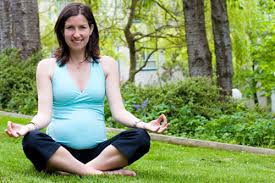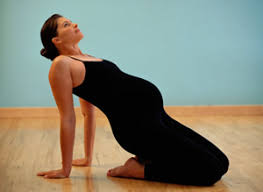YOGA during Pregnancy

The Practice of Yoga can help you prepare your mind and body for labor and birth as this helps you focus, to concentrate and keep you healthy. The Yoga Postures are gentle ways of keeping your body active and supple and minimize the common Pregnancy Symptoms like morning sickness and constipation. It can also help in ensuring easier labor and

smooth delivery by relieving tension around the cervix and birth canal and by opening the pelvis. The Breathing Techniques can also become handy during labor. It also helps in restoring your body shape, uterus, abdomen, and pelvic floor, and in relieving upper back tension and breast discomfort after childbirth. Special care, however, is needed in choosing the Yoga Poses that you will practice, you should avoid poses that requires laying on the back or belly.

smooth delivery by relieving tension around the cervix and birth canal and by opening the pelvis. The Breathing Techniques can also become handy during labor. It also helps in restoring your body shape, uterus, abdomen, and pelvic floor, and in relieving upper back tension and breast discomfort after childbirth. Special care, however, is needed in choosing the Yoga Poses that you will practice, you should avoid poses that requires laying on the back or belly.
For the first trimester, standing Yoga Poses are advised as this will help strengthen the legs, promote Circulation, generate energy, and may reduce leg cramps. It is also advisable to do some stretching such as the hamstrings stretch to avoid Sciatica. During the second and third trimester, you may reduce your time spent for practicing the Asanas to prevent fatigue and overwork. It is also not advised to practice from the tenth to through the fourteenth week of Pregnancy since these are crucial times. Supine poses, backbends, and twisting can also be done with modification or if the body is on an incline. Do not overstretch the abdomen; the emphasis of your twisting poses should be on the shoulders and the upper back and not on the abdomen. Avoid doing inversion poses though some experience Yoga practitioners usually still feel comfortable doing this until the seventh month.
The following are the Yoga Poses that can help you in dealing with the symptoms of Pregnancy, ensuring smoother and easier delivery, and faster recovery after childbirth. Poses that put pressure on the abdomen and other difficult poses should not be done during advance stages of Pregnancy. You do not have to do all these Asanas and remember not to push yourself on a pose.
Mountain Pose (Tadasana)
The Mountain Yoga Pose promotes the experience of stillness, strength, relaxed power, and immovable stability associated with mountains. This yoga posture, and coming back to this stillness after other poses, is one of the ways of becoming acquainted with stillness.
Triangle Pose (Trikonasana)
In Hindu art, the triangle is a potent symbol for the divine principle, and it is frequently found in the yantras and mandalas used for meditation. The Trikonasana or Triangle Pose concludes the Yoga Postures in our basic session.
Warrior Pose
The Warrior Pose stretches and strengthens the arms and legs, increases stamina, improves balance and concentration, and can also relieve backaches. If you are suffering from diarrhea, high blood pressure or neck problems, you should take extra caution practicing this pose.
Standing Side Stretch Pose
The Standing Side Stretch is another Yoga Pose with two lines of energy radiating outward from your center. This is a simple Yoga Posture with a wonderful stretch in which one line of energy reaches upward from your belly and outward through the arm, and one line travels downward through the legs.
Standing Spread Leg Forward Bend
Practicing the Standing Spread Leg Forward Fold can strengthen and stretch your inner and back legs and your spine. People with lower back problems should avoid doing the full forward bend. For beginners, you may use props like a folding chair to support your forearms.
Seated Forward Bend (Paschimothanasana)
Relax your body and mind, stretch your hamstrings, shoulders, and spine, relieve stress, and improve your posture and concentration by practicing the Seated Forward Bend. Learn how to do this properly and achieve maximum results.
Hero Pose (Virasana)
One of the fundamental seated postures is the Hero Pose. This serves as the initial position for several Asanas. It strengthens the arches of the feet, stretches the ankles, and improves posture. This Yoga Pose is ideal for people who have flat feet.
Spread Leg Forward Fold (Upavista Konasana)
The Spread Leg Forward Fold is a Yoga Posture which works primarily on the hamstrings and adductors. This energizes the body and promotes inner calmness. In this section, know more about this exercise and learn how to perform it properly.
Fish Yoga Pose
Doing the Fish Pose relieves stiffness of the neck and shoulder muscles and improves flexibility of your spine. It is the counter-pose of the Shoulderstand. Hold the Fish Pose for at least half the amount of time you spent in the Shoulderstand in order to balance the stretch.
Cat Pose (Bidalasana)
The Cat Yoga Pose teaches you to initiate movement from your center and to coordinate your movement and breath. These are two of the most important themes in Yoga practice. Keep in mind that the Cat Pose may not be advisable if you have any chronic or recent back pain or injury.
Tree Yoga Pose
The Tree Pose helps strengthen your thighs, calves, ankles and back. It can also increase the flexibility of your hips and groin. Your balance and concentration can also be improved with constant practice. This Yoga Pose is recommended for people who have sciatica and flat feet.
Plough Pose (Halasana)
The Plough Pose stretches your spine, thus, improving spinal flexibility. It benefits the thyroid gland and abdomen, eases tension in the shoulders and back, and reduces stress. Learn how to practice the Plough Pose in this section.
Shoulder Lifts
Many people hold tension in their necks and shoulders, leading to stiffness, bad posture, and tension headaches. Yoga practice can ease tension, increase flexibility, and tone the muscles. This section covers the steps on how to practice Shoulder Lifts.
Neck Exercises
Many people hold tension in their necks and shoulders, leading to stiffness, bad posture, and tension headaches. Yoga practice can ease tension, increase flexibility, and tone the muscles. Learn some Neck Exercises in this section.
New Research- How Yoga Can Fight Depression during Pregnancy
Although many pregnant women experience hormonal mood swings, in some expectant mothers it is much more serious; one in five pregnant women experiences a major depression. A study featured in the journal Complementary Therapies in Clinical Practice reveals pregnant women with major depression may benefit from an old recommended stress reliever, i.e. yoga.
Researchers of the University of Michigan Health System pilot feasibility study assessed psychiatrically high-risk pregnant women who were between 12 to 26 weeks pregnant and who participated in 90-minute mindfulness yoga sessions over a 10-week period, which concentrated on postures for pregnant women as well as raising awareness of how the body changes as the baby grows. At the end of the study the team discovered considerable reductions in depressive symptoms, whilst the mothers reported of also having a stronger attachment to their babies in the womb.
Lead author Maria Muzik, M.D., M.S., assistant professor of psychiatry and assistant research scientist at the Center for Human Growth and Development said, “We hear about pregnant women trying yoga to reduce stress but there's no data on how effective this method is. Our work provides promising first evidence that mindfulness yoga may be an effective alternative to pharmaceutical treatment for pregnant women showing signs of depression. This promotes both mother and baby wellbeing."
Mental health disorders during pregnancy, such as anxiety and depression are a serious health concern. Some pregnant women feel persistent irritability, feelings of being overwhelmed and inability to cope with stress, which is brought on by hormonal changes, genetic predisposition and social factors. If these symptoms remain untreated, they will present mother and baby with major health risks, such as preeclampsia, premature labor, poor weight gain and problems in bonding with the new baby.
Muzik states that even though antidepressants are evidently effective in treating these mood disorders, earlier research demonstrated that many expectant mothers are reluctant to take these drugs because they are concerned about their child's safety.
Muzik continues, unfortunately, few women suffering from perinatal health disorders receive treatment, exposing them and their child to the negative impact of psychiatric illness during one of the most vulnerable times. That's why developing feasible alternatives for treatment is critical.
According to evidence, women feel safer with non-traditional treatments, such as herbal medicine, relaxation techniques and mind-body work. Even though yoga is continuing to become more increasingly popular in the U.S., the researchers say that many classes treat yoga as 'exercise' rather than the practice of being fully present in the moment and conscious. Mindfulness yoga, a combination of meditation and physical postures, has demonstrated to be a powerful approach in boosting energy and combating stress.
Muzik concludes, Research on the impact of mindfulness yoga on pregnant women is limited but encouraging. This study builds the foundation for further research on how yoga may lead to an empowered and positive feeling toward pregnancy.
(Source-Journal Complementary Therapies in Clinical Practice)
No comments:
Post a Comment